These Sourdough Discard Blueberry Bagels are light and fluffy, packed with fresh blueberries, and have a slight sourdough tang. They're slightly sweet, perfect for breakfast or brunch, and are an easy variation of my Sourdough Discard Bagels recipe.
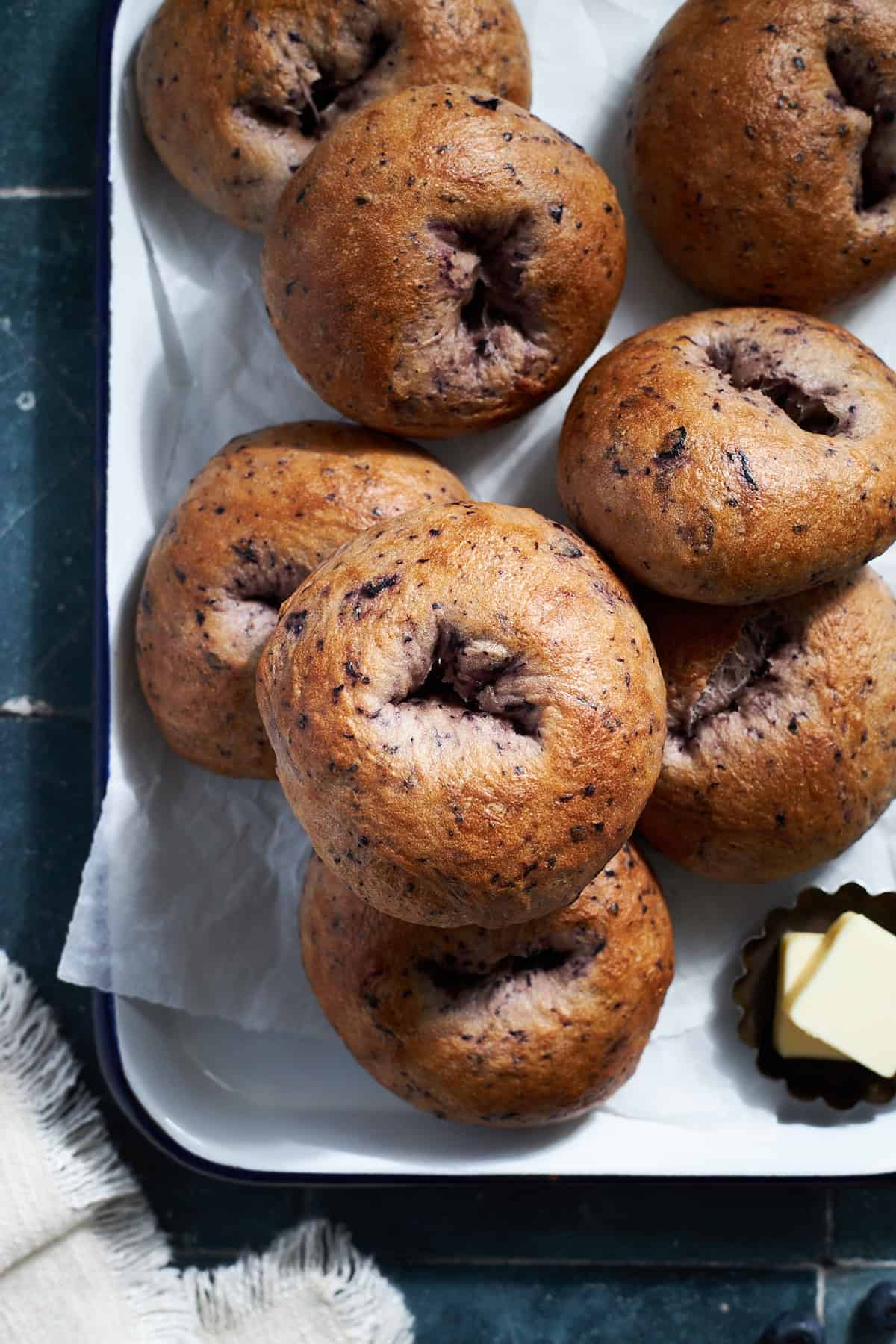
If you're looking for other sourdough discard recipes, try these Sourdough Discard Cinnamon Rolls, Sourdough Discard Waffles, and this Sourdough Discard Apple Pull Apart Bread.
I finally worked up enough courage to try making these. Fantastic recipe! Very easy to follow. Thank you!
- Erica
Why you'll love this recipe
- These bagels are made with fresh blueberries, but can also be made with frozen berries if you prefer! We coarsely crush or purée the blueberries to try to get maximum flavor into the bagels.
- Sourdough Discard Blueberry Bagels are slightly sweet and perfect for breakfast or brunch. And if you like a sweet bagel, try these Sourdough Discard Cinnamon Raisin Bagels.
- This recipe is a great way to use up some of your sourdough discard, but you can also make an easy modification to use active sourdough starter if you prefer.
- Bagels freeze well so it's easy to enjoy a few while they're fresh, and freeze the rest to enjoy later!
Jump to:
Ingredients
I recommend making this recipe with fresh blueberries, but it can also be done with frozen berries. As long as you have sourdough discard, you are well on your way to making these blueberry bagels!
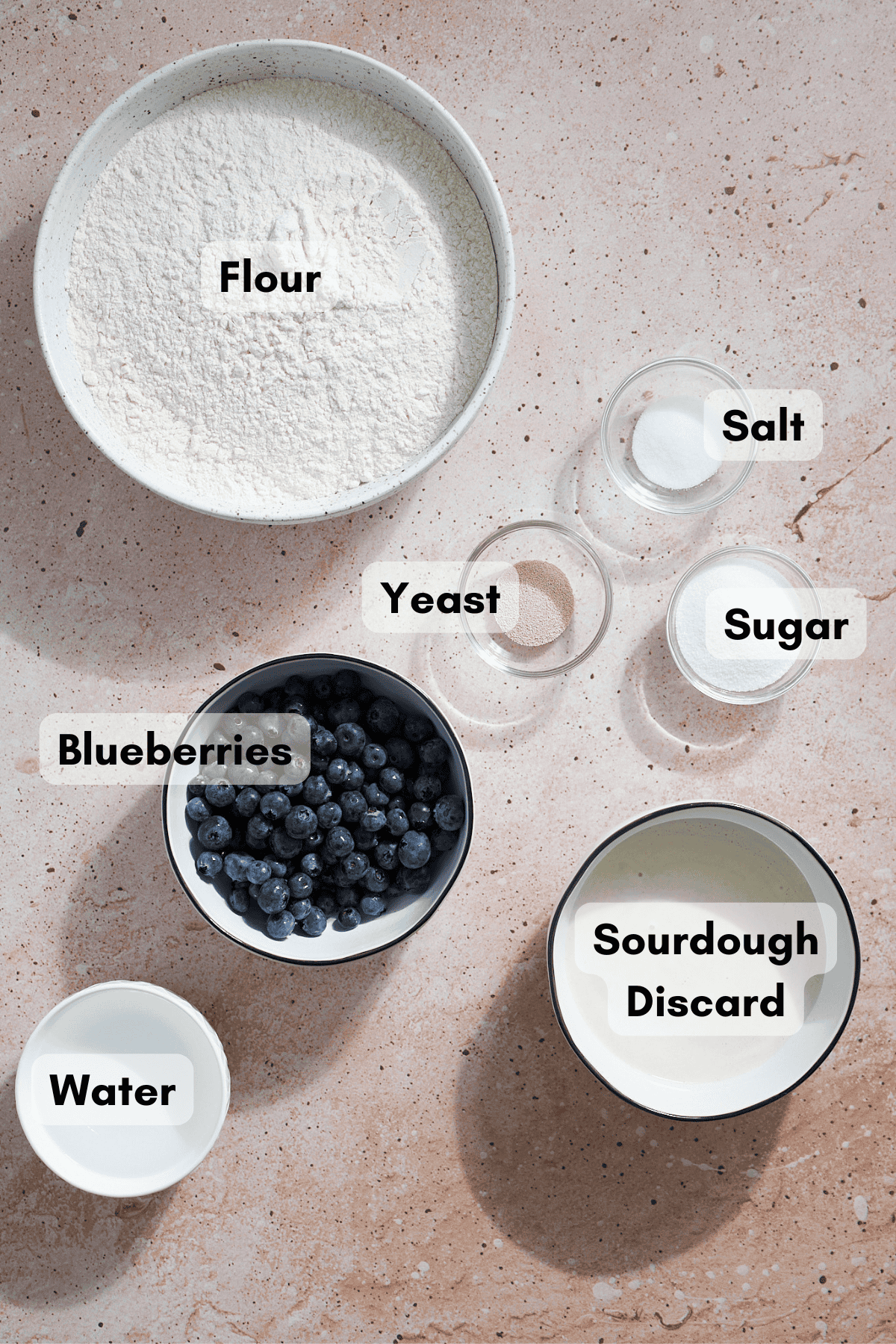
- Sourdough discard: The sourdough discard should be unfed and at room temperature for this recipe. This recipe is designed for a sourdough starter with a 1:1 ratio (when you feed your starter, it's with 1 part flour and 1 part water). If your starter uses a different ratio, you may need to make adjustments to the recipe.
- Learn more about making a homemade sourdough starter.
- Blueberries: I highly recommend using fresh blueberries to make these bagels. We will coarsely crush or purée the blueberries to get as many as possible (and as much flavor as possible) into the bagels! It also works best if the blueberries are room temperature (not cold, right from the fridge).
- In a blueberry mood? Try these Sourdough Discard Blueberry Muffins, too!
See full recipe below for detailed directions.
Substitutions & Variations
This is a very adaptable recipe and below are a few easy substitutions and variations you can try.
- Use active sourdough starter - If you'd like to make these bagels with active sourdough starter, you can! To do so, omit the yeast and replace the sourdough discard with active sourdough starter (1:1 substitution). You will also need to adjust the rise times.
- Add blueberry extract - The flavor from the blueberries in the bagels is subtle and may not be what you experience at your favorite deli, for example. If you want even more blueberry flavor, try adding 1 teaspoon of blueberry extract!
- Use frozen blueberries - If you're using frozen blueberries, let them thaw before coarsely crushing or puréeing the berries. This will help ensure that you're accurately feeling the water content of the dough. You may find that you need to add some additional water to the recipe when using frozen berries, as they will have lost some of their water content.
- Boil with honey - This recipe boils the bagels in water with 2 Tablespoons of granulated sugar, but you can also substitute that sugar with honey or agave nectar.
- If you're interested in a different bagel flavor, try these Sourdough Discard Protein Bagels and these Sourdough Discard Strawberry Bagels.
A note on dried blueberries: You can use dried blueberries to make this recipe, but frankly I don't recommend it. The water content changes a lot with the dried berries (i.e. you'll need to add more water), and I find the final flavor is not as good!
I have not tested this recipe with other variations, but if you do, let us know how it turns out in the comments! I always love to hear how you're adapting these recipes and use those as ideas for future recipes as well!
How to Make Sourdough Discard Blueberry Bagels
Kneading the dough (and getting the right consistency) is the hardest part, but you'll have this recipe ready to go in no time!
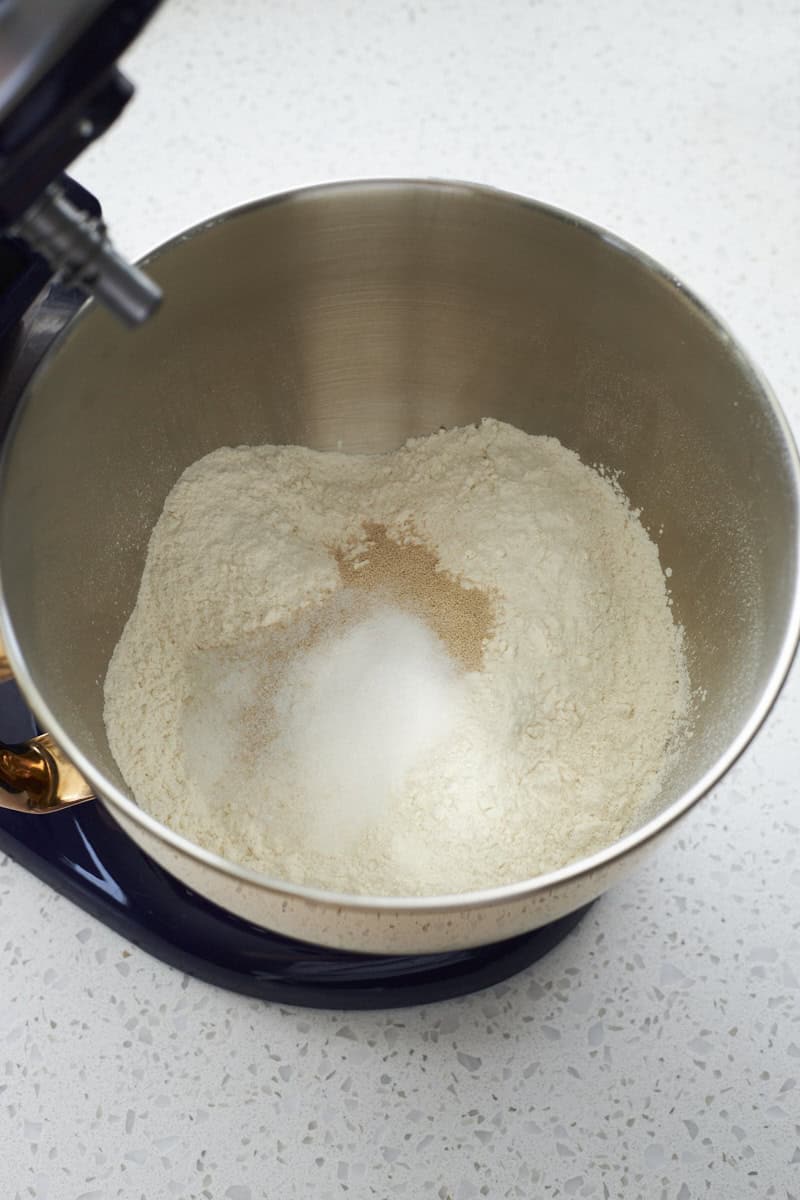
Combine the dry ingredients in the bowl of a stand mixer fitted with a dough hook (or in a large bowl with a wooden spoon).
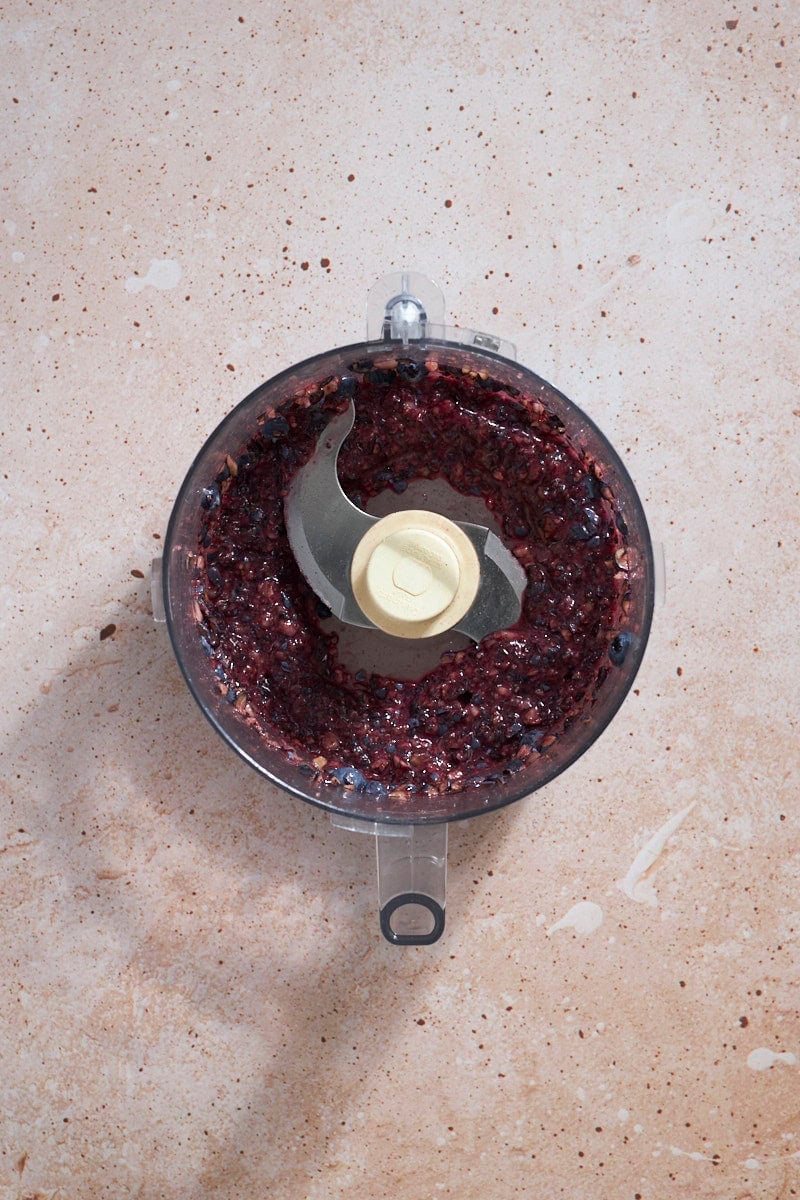
Coarsely crush or pulse to purée the blueberries in a food processor. I like to leave some chunks here - it doesn't need to be completely smooth! Measure this carefully: you want to use 1 cup of crushed blueberries.

Add the crushed blueberries, sourdough discard, and water to the bowl. Mix until a shaggy dough forms.
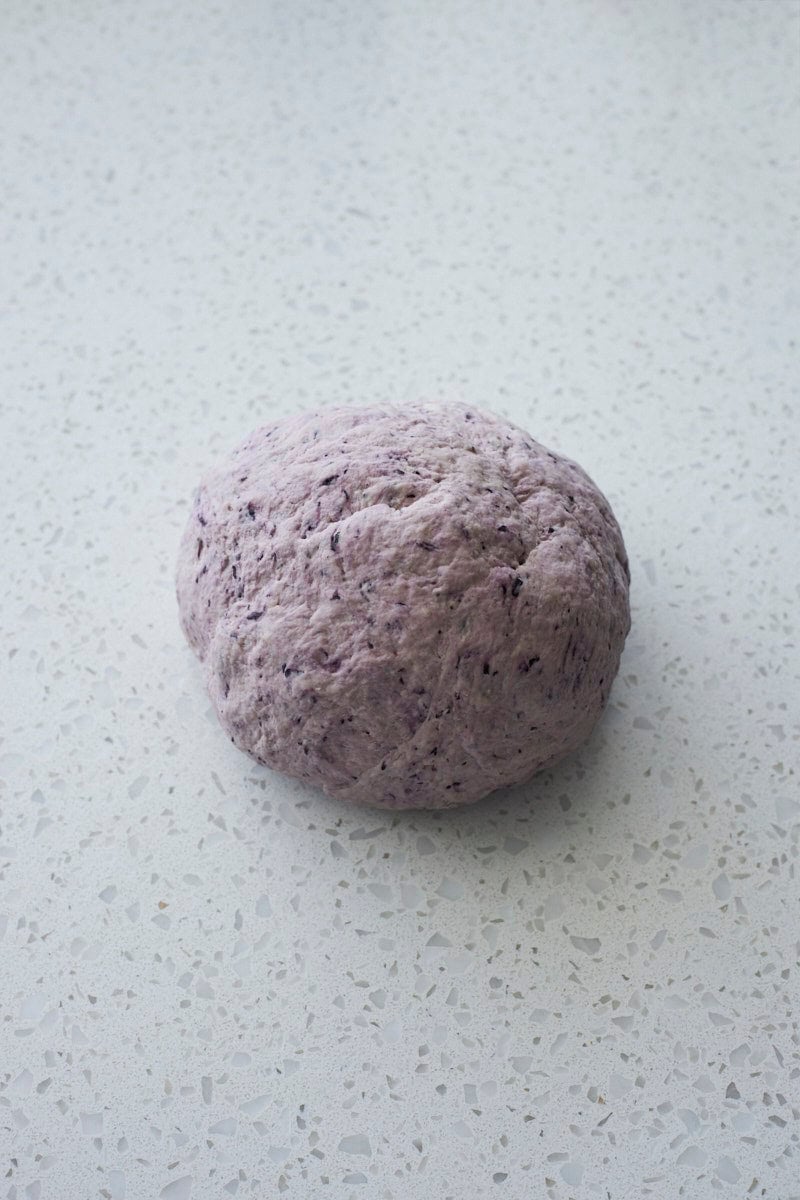
Transfer the dough to a work surface and knead for 4-5 minutes. Add more water or flour (1 Tablespoon at a time) if needed. The dough should be smooth and not sticky. Transfer the dough to a large, greased bowl and let rise for 90 minutes, or until doubled in size.
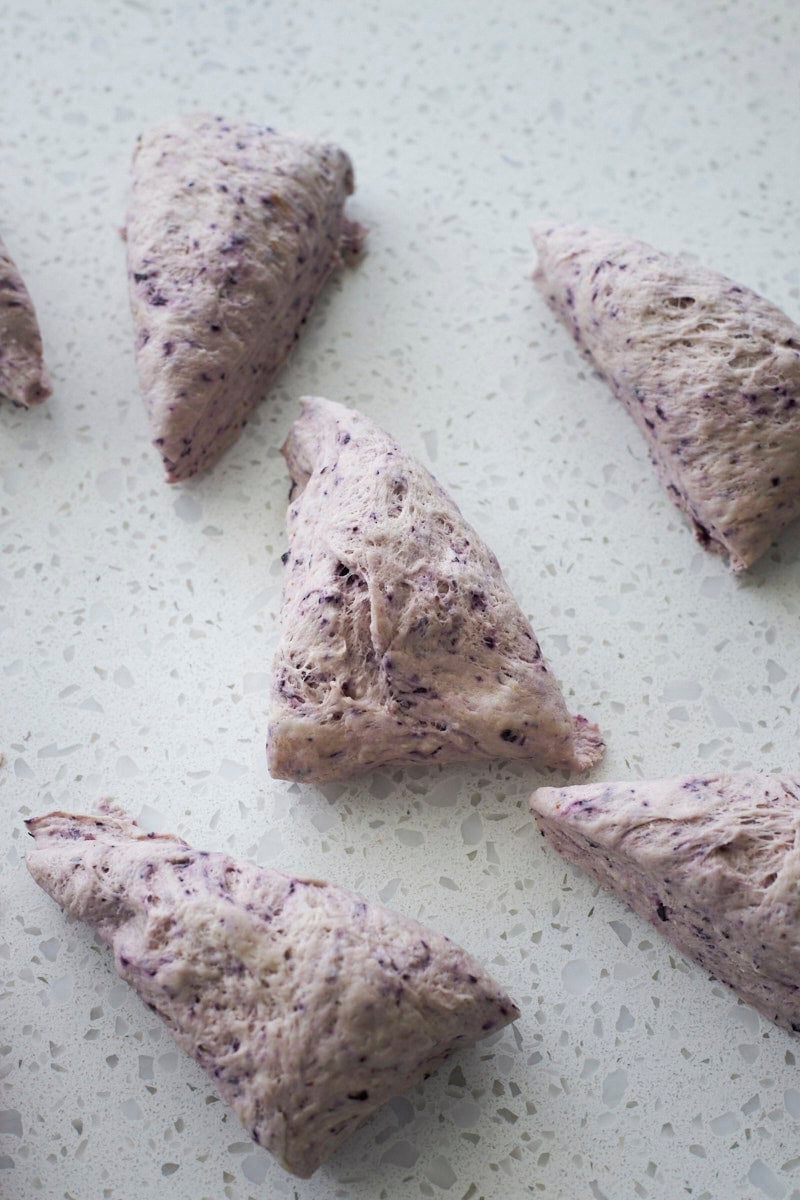
Turn the dough onto a work surface and divide into 8 equal-sized pieces. This doesn't have to be exact (but if you want them to be exact, you can measure each piece on a kitchen scale).
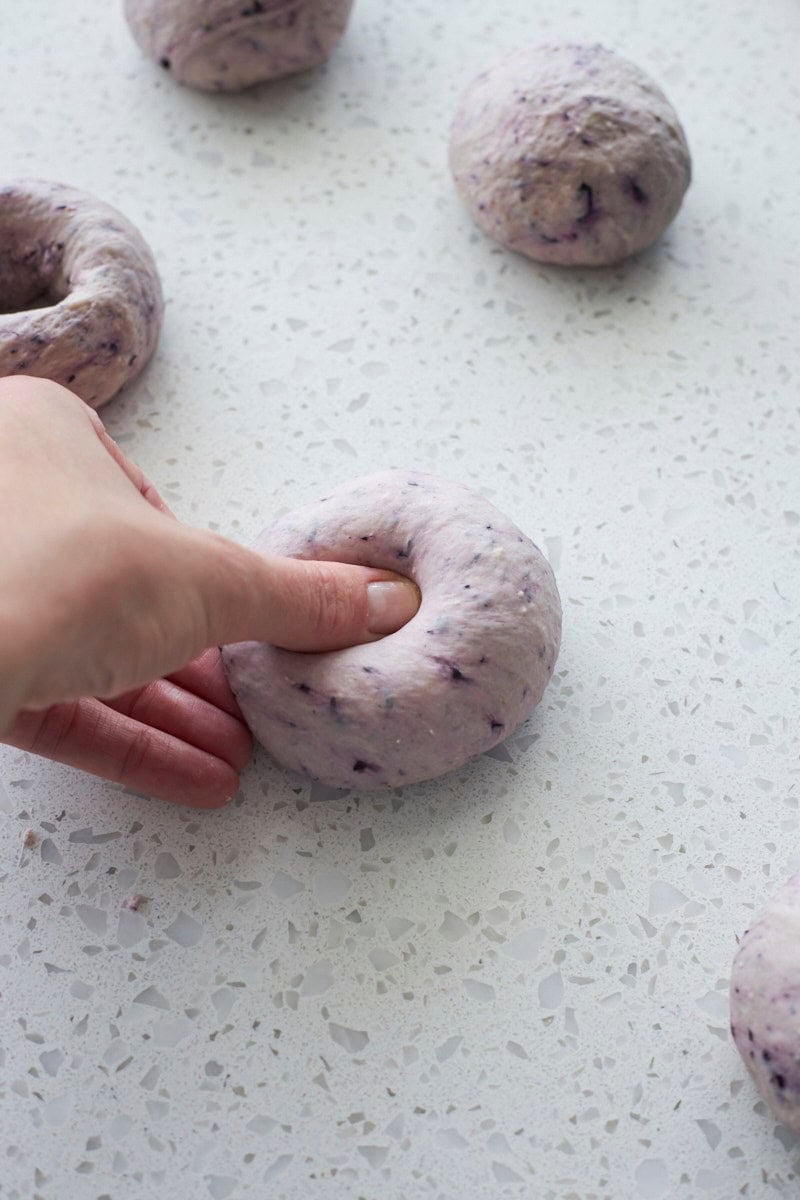
Using your palm to create friction, roll each piece into a ball. Use your thumb to press through the center of the dough ball and stretch to form a hole. Make the hole bigger than you think it should be - this will shrink as the dough bakes and expands. Cover and let the bagels rest for 20 minutes.
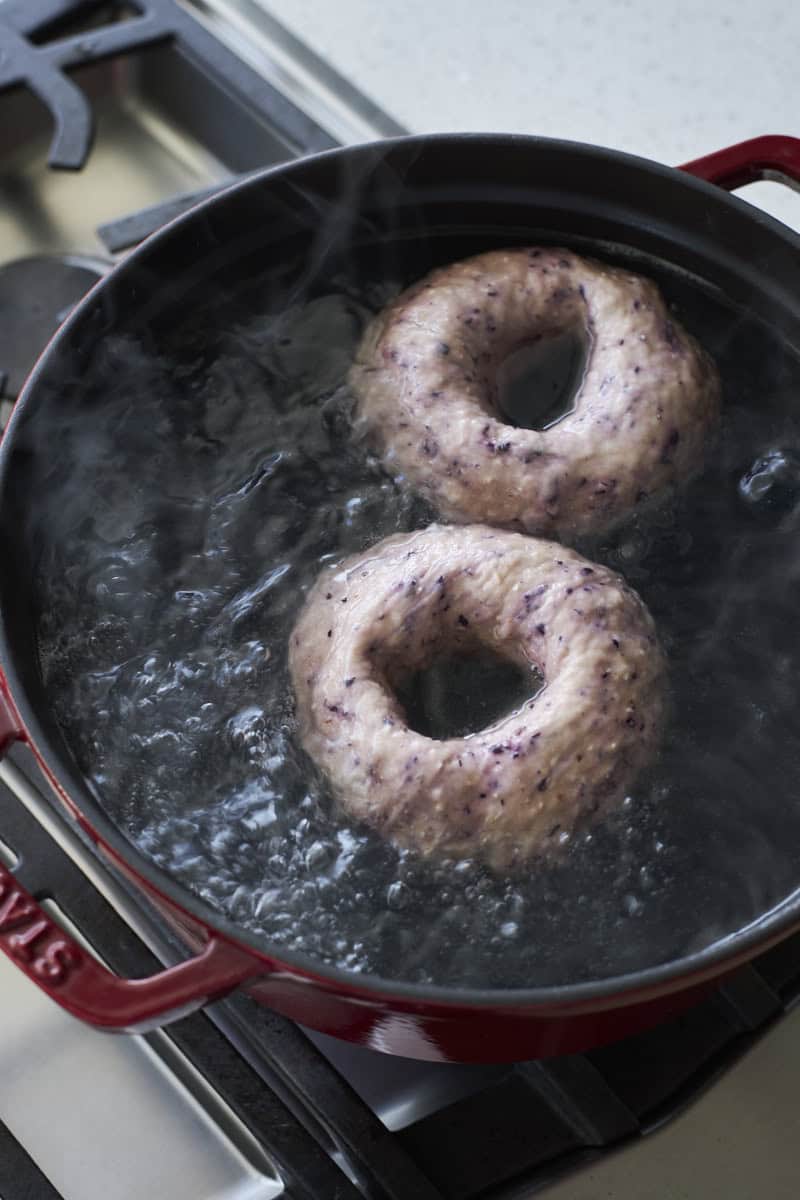
Boil the bagels for 15-30 seconds on each size. Shake off any excess water and transfer to your baking sheet.
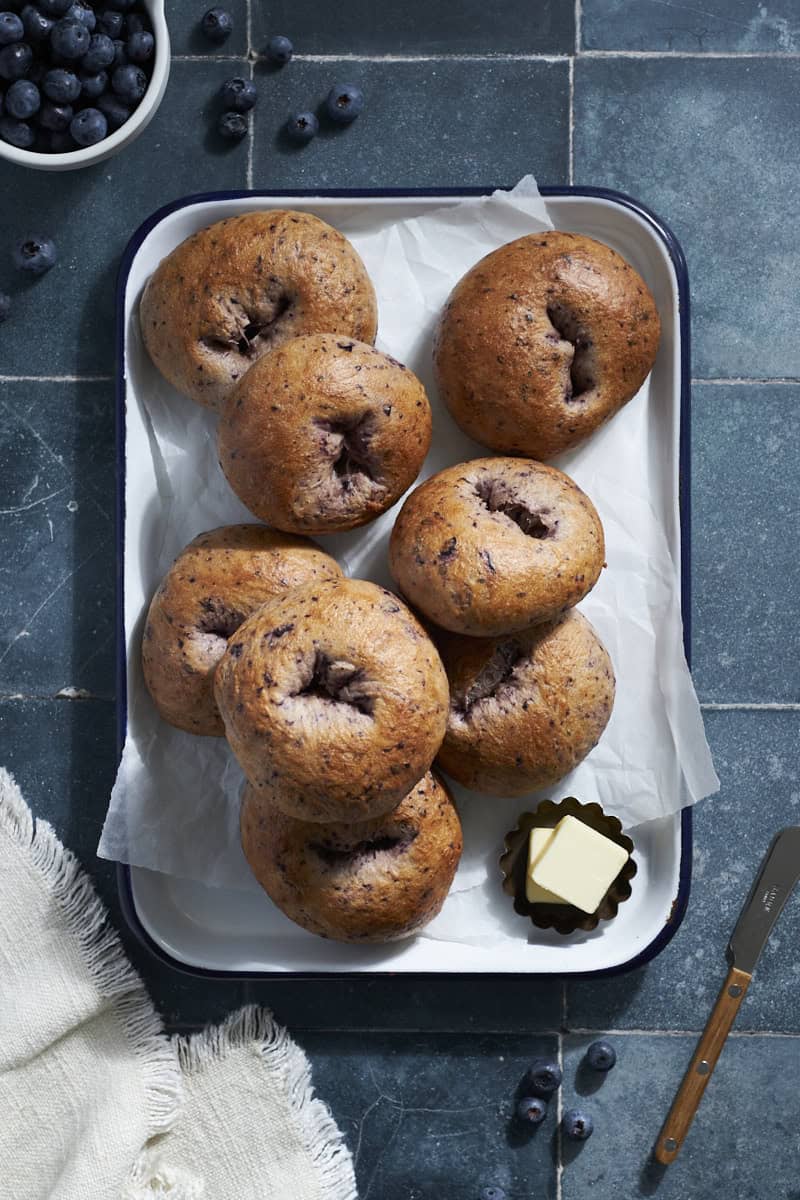
Bake until golden brown, then transfer to a cooling rack to cool fully.
Expert Baking Tips
- Crushing or puréeing the berries allows us to incorporate more berries into the dough and more accurately measure the amount of liquid in the dough.
- A previous version of this recipe used whole blueberries, which were then crushed during the kneading process. This will work! But it's hard to know just how much liquid will be released by the berries (it's a lot!).
- Use room-temperature blueberries. If your berries are cold (right out of the fridge), this will really slow down your rise.
- Make sure you knead the dough long enough. The dough should be smooth and not sticky. This will give your bagels the correct look and texture!
- Make the center hole larger than you think it should be. The bagels will expand quite a bit during the boiling and baking processes, so make it a bigger hole than you think!
- The boiling step is crucial for forming the crust. Boiling for a longer time will give you a thicker crust.
- Bagels freeze very well. I always eat one or two fresh, and then freeze the rest to enjoy later! You can freeze a batch of these Sourdough Discard Rosemary Salt Bagels or these Sourdough Discard Pumpkin Bagels, too!
Troubleshooting with Bagels
There are a few common issues that come up when baking bagels.
- Dough is too wet / too dry: After you knead the dough, it should be fairly sturdy (but not hard) and not sticky. If the dough is too wet, add 1 Tablespoon flour at a time until the dough smooths out. If the dough is too dry, add 1 Tablespoon water at a time until you can make a smooth dough.
- Bagels are sticking to the parchment paper: There are a few things that could cause this.
- First, make sure to shake off the excess water after boiling the bagels. Excess water can make the bagels sticky.
- Check the type of parchment paper you're using. Some are not designed for higher baking temperatures (and we're baking at a high temperature for this recipe!). I recommend using this parchment paper or a silicone baking mat (such as a Silpat mat).
- Lastly, some ovens (like mine) heat unevenly and are hotter on the top or the bottom. Make sure to flip and rotate your pans while baking so the bagels on each pan bake evenly!
- Bagels look shaggy after baking: If your bagels are looking shaggy and not smooth after baking, the dough was not kneaded for long enough. Make sure to knead until you have a smooth dough!
- Center hole has completely filled: This means the hole was not shaped to be large enough. Remember that the dough rises and expands quite a bit! Stretch the hole to be larger than you think it should be.
Storage
Room Temperature Storage: These bagels are best fresh, of course! Once cooled, they can be stored in a sealed plastic bag at room temperature for up to three days. Reheat the bagels in the microwave for about 30 seconds to make them warm and soft again.
Freezer Storage: These bagels freeze well! Once fully cooled, transfer the bagels to a freezer-safe plastic bag or container and freeze for up to 3 months. I like to freeze them in individual plastic bags so I can reheat just one bagel whenever I like. Reheat frozen bagels in the microwave for about 60 seconds until warm and soft again.
Recipe FAQs
Sourdough discard is what is left over after you feed your sourdough starter. You can either literally discard this (in the trash or compost), or use it in sourdough discard recipes like this one!
If you're new to working with sourdough starter, check out these in-depth guides on how to feed sourdough starter, how to use sourdough discard, and tips for struggling sourdough starter.
Yes, you can! To do so, omit the yeast and replace the sourdough discard with active sourdough stater (1:1 substitution). You will also need to adjust the rise times.
Yes! If you're using frozen blueberries, let them thaw before coarsely crushing or puréeing the berries. This will help ensure that you're accurately feeling the water content of the dough. You may find that you need to add some additional water to the recipe when using frozen berries, as they will have lost some of their water content.
Sourdough discard is not as active as the active sourdough starter. Therefore, you need to use a leavening agent (in this case, yeast) to make sure the dough rises predictably.
I recommend freezing them! Once fully cooled, transfer the bagels to a freezer-safe plastic bag or container and freeze for up to 3 months. I like to freeze them in individual plastic bags so I can reheat just one bagel whenever I like. Reheat frozen bagels in the microwave for about 60 seconds until warm and soft again.
More Sourdough Discard Breakfast Recipes
If you tried these Sourdough Discard Blueberry Bagels or any other recipe on my website, please leave a star rating and let me know how it went in the comments below. I'd love to hear from you! Happy Baking!

Sourdough Discard Blueberry Bagels
Ingredients
- 3 ¾ cups bread flour
- 3 Tablespoons granulated sugar divided
- 2 teaspoons kosher salt
- 1 teaspoon instant yeast
- 1 ½ cups fresh blueberries at room temperature
- 200 grams (about ¾ cup) sourdough discard unfed, at room temperature
- ¼ cup + 2 Tablespoons warm water
Instructions
- Combine flour, 1 Tablespoon granulated sugar, salt, and instant yeast in the bowl of a stand mixer fitted with a dough hook*. Stir to combine.
- Coarsely crush or purée the blueberries in a food processor. You will need 1 cup (220g) of crushed berries.
- Add the sourdough discard and crushed blueberries to the dry ingredients. With the mixer on low speed, slowly pour in the warm water. Mix until a shaggy dough forms.
- Turn the dough to a work surface and knead for 4-5 minutes until a smooth dough forms. The dough should be smooth and not sticky. If needed, add more flour or water (1 Tablespoon at a time) to reach your desired consistency.
- Transfer the dough to a large, greased bowl and cover with plastic wrap. Let the dough rise for 90 minutes or until doubled in size.
- Turn the dough out onto a smooth surface and divide into 8 equal-size pieces. Using the palm of your hand, roll each piece into a smooth ball. Use your thumb to press through the center of each ball, stretching the hole to form your bagel shape. Make this hole larger than you think it should be - the dough will expand quite a bit while boiling and baking. Lightly cover the bagels with a clean dish towel or plastic wrap to rest for 20 minutes while you prepare the next step.
- Preheat the oven to 425°F. Line 2 baking sheets with parchment paper and set aside. Bring a pot with 2 quarts of water and 2 Tablespoons granulated sugar to boil.
- Place each bagel in the boiling water for 15-30 seconds on each side**. You can likely fit 2-3 bagels in the pot at a time, but make sure there is enough room for them to float openly. Remove the bagels from the boiling water using a slotted spoon or spatula, letting excess water drip off, and transfer to the prepared baking sheets. If needed, you can reshape the bagels a little after they've cooled.
- Bake for 18-22 minutes or until golden brown. Let cool fully before slicing and serving.

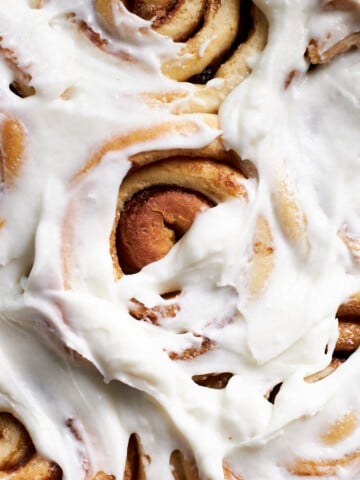



Gillian Curia says
I’m confused, but maybe I just didn’t see it… Where did the other 2 tablespoons of granulated sugar go if we only use one in the dough? Thanks!
Jessica Vogl says
The other two are in the boiling water during the boiling step!